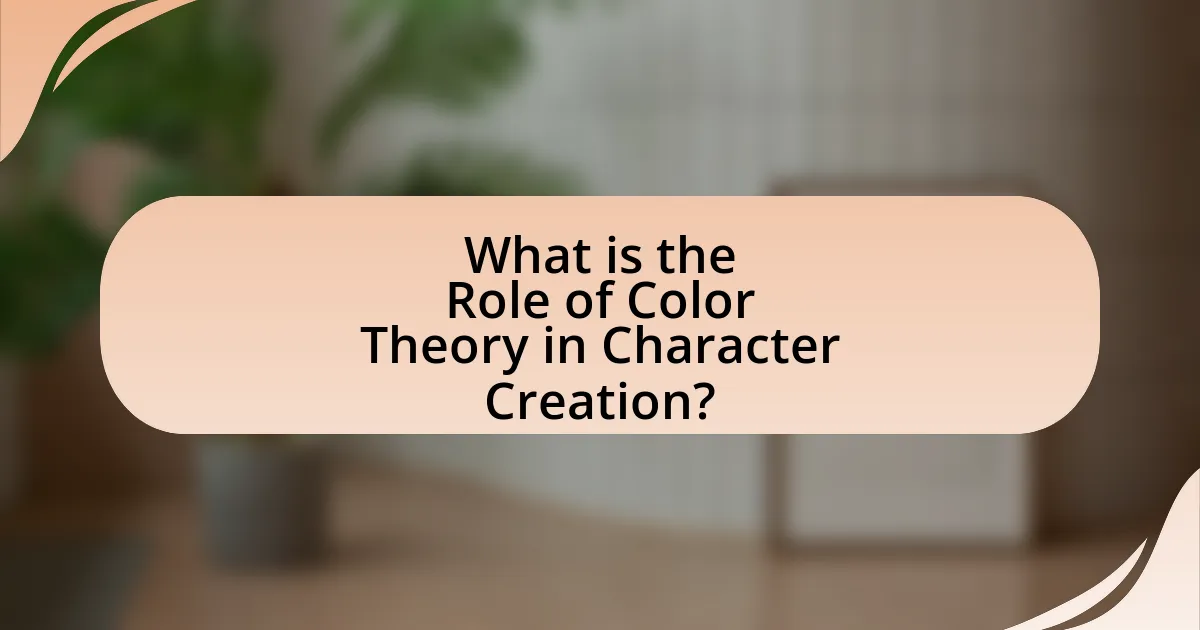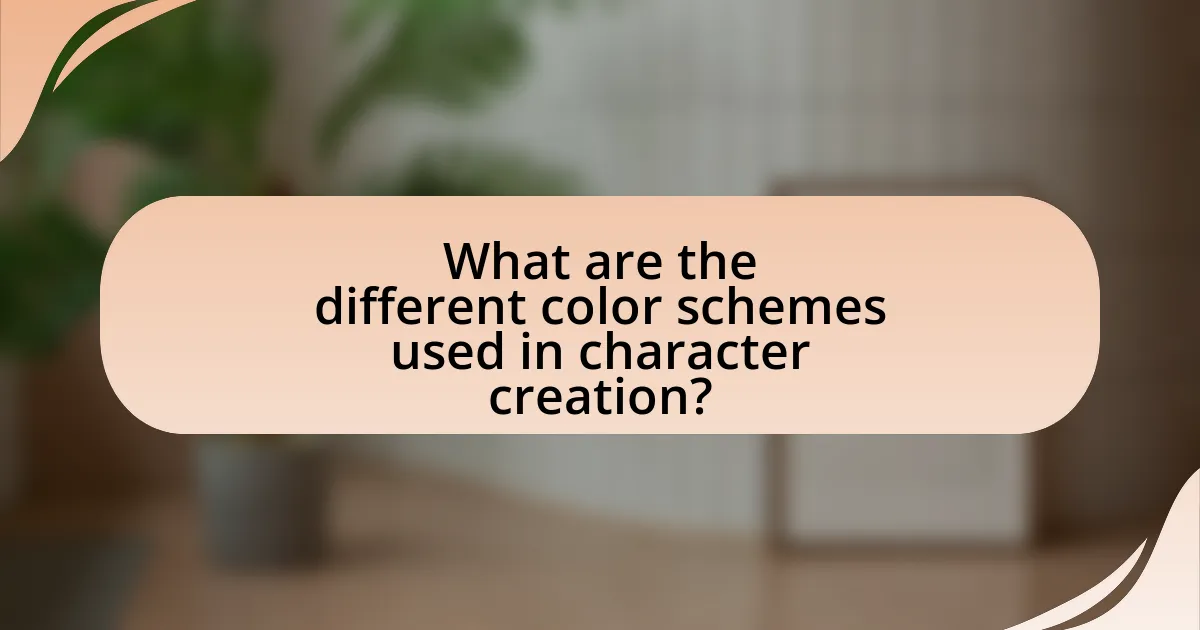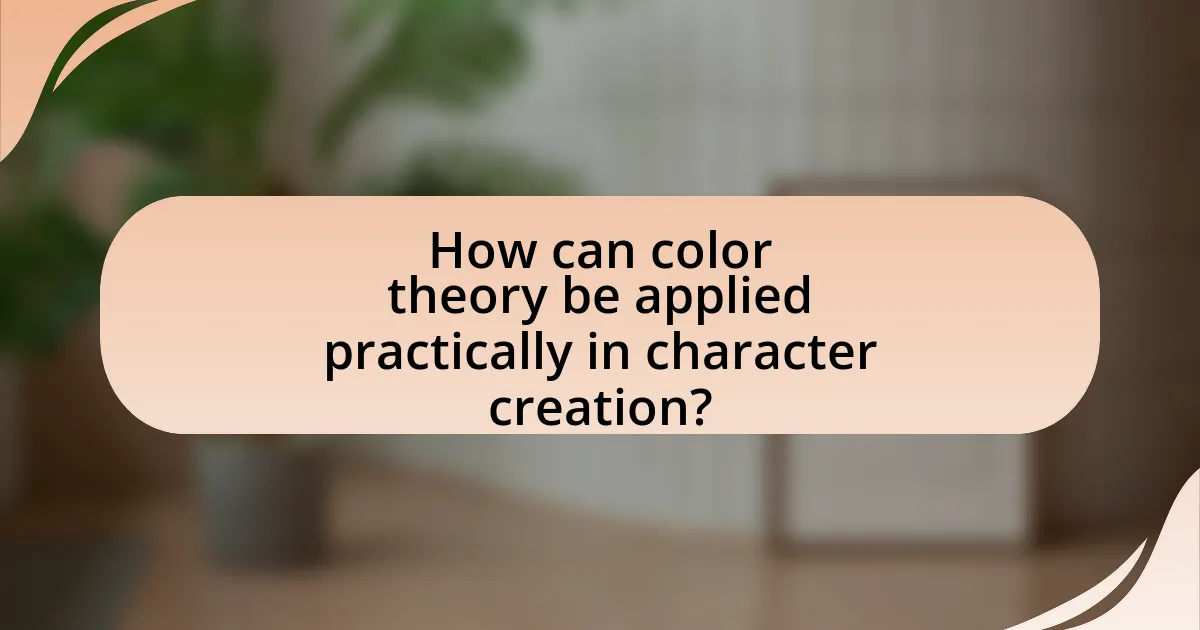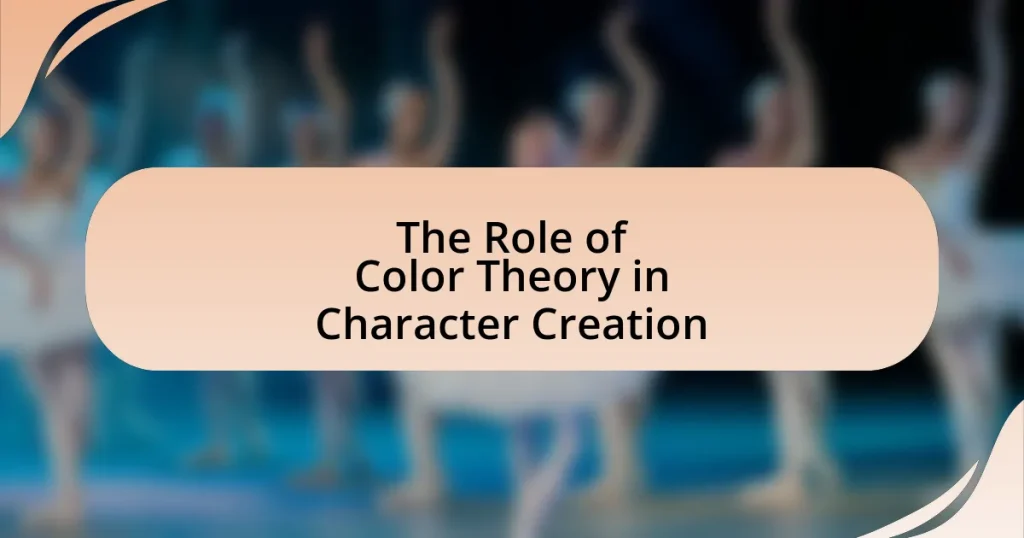The article focuses on the role of color theory in character creation, emphasizing its significance in shaping audience perceptions and emotional responses. It explores how specific colors can convey personality traits, evoke emotions, and enhance storytelling through strategic color selection. Key principles of color theory, including color harmony and psychological effects, are discussed alongside practical applications in character design, such as the use of complementary and analogous color schemes. The article also highlights tools and best practices for effectively implementing color theory in character development, ensuring that creators can enhance visual appeal and audience engagement.

What is the Role of Color Theory in Character Creation?
Color theory plays a crucial role in character creation by influencing how characters are perceived and understood by the audience. The use of specific colors can evoke emotions, convey personality traits, and establish thematic connections. For instance, red often symbolizes passion or aggression, while blue can represent calmness or sadness. Research in psychology indicates that colors can significantly affect mood and behavior, which supports the idea that color choices in character design can enhance storytelling and audience engagement. By strategically applying color theory, creators can deepen the audience’s connection to characters and enhance the overall narrative experience.
How does color theory influence character design?
Color theory significantly influences character design by guiding the selection of colors that convey emotions, traits, and narratives. For instance, warm colors like red and orange can evoke feelings of passion or aggression, while cool colors such as blue and green often represent calmness or tranquility. This strategic use of color helps designers create visually compelling characters that resonate with audiences on an emotional level. Research indicates that color associations are culturally influenced; for example, in Western cultures, red is often linked to danger or excitement, while in Eastern cultures, it may symbolize luck and prosperity. Thus, understanding color theory allows character designers to effectively communicate personality and mood, enhancing the overall storytelling experience.
What are the fundamental principles of color theory?
The fundamental principles of color theory include the color wheel, color harmony, and the psychological effects of color. The color wheel organizes primary colors (red, blue, yellow), secondary colors (green, orange, purple), and tertiary colors, providing a visual representation of color relationships. Color harmony refers to the aesthetically pleasing combinations of colors, such as complementary, analogous, and triadic schemes, which create balance and visual interest. The psychological effects of color influence emotions and perceptions; for example, blue often evokes calmness, while red can signify excitement or urgency. These principles are essential in character creation, as they guide artists in selecting colors that enhance storytelling and emotional impact.
How do colors evoke emotions in character creation?
Colors evoke emotions in character creation by influencing the audience’s perception and emotional response to a character’s traits and narrative. For instance, red often symbolizes passion or aggression, while blue can convey calmness or sadness. Research in color psychology supports this, indicating that colors can trigger specific emotional reactions; for example, a study published in the journal “Color Research and Application” by K. A. Valdez and A. Mehrabian found that warm colors like red and yellow are associated with excitement and warmth, whereas cool colors like blue and green are linked to tranquility and sadness. This understanding allows creators to strategically use color palettes to enhance character development and emotional depth, making characters more relatable and impactful.
Why is color selection important in character development?
Color selection is important in character development because it conveys emotions, personality traits, and thematic elements effectively. For instance, colors like red can symbolize passion or aggression, while blue often represents calmness or sadness. This psychological impact of color is supported by studies in color theory, which indicate that specific colors evoke particular feelings and associations in viewers. By strategically choosing colors for a character’s design, creators can enhance storytelling and audience connection, making the character more relatable and memorable.
What psychological effects do different colors have on audiences?
Different colors evoke specific psychological effects on audiences, influencing emotions and perceptions. For example, red often stimulates feelings of excitement and urgency, making it effective in marketing and branding. Blue tends to promote calmness and trust, frequently used by financial institutions to convey reliability. Yellow can evoke happiness and optimism but may also cause anxiety in excessive amounts. Green is associated with nature and tranquility, often used to represent health and wellness. Research by Andrew Elliot and Markus Maier in “Color and Psychological Functioning: A Review of Theoretical and Empirical Work” (2014) supports these associations, demonstrating that color can significantly impact mood and behavior.
How can color choices reflect a character’s personality?
Color choices can reflect a character’s personality by symbolizing specific traits and emotions associated with different hues. For instance, red often signifies passion or aggression, while blue typically represents calmness and stability. These associations are rooted in color psychology, which suggests that colors can evoke particular feelings and perceptions in individuals. Research indicates that colors can influence mood and behavior; for example, a study published in the journal “Color Research and Application” by Andrew Elliot and Markus Maier found that red can enhance feelings of excitement and urgency. Therefore, a character who frequently wears red may be portrayed as impulsive or energetic, while one who opts for blue may be depicted as serene or trustworthy.

What are the different color schemes used in character creation?
The different color schemes used in character creation include monochromatic, analogous, complementary, triadic, and tetradic schemes. Monochromatic schemes utilize variations in lightness and saturation of a single color, creating a cohesive look. Analogous schemes involve colors that are next to each other on the color wheel, promoting harmony. Complementary schemes use colors opposite each other on the wheel, providing contrast and vibrancy. Triadic schemes consist of three colors evenly spaced around the wheel, balancing contrast and harmony. Tetradic schemes involve two complementary color pairs, allowing for rich and diverse palettes. These schemes are foundational in visual storytelling, influencing character perception and emotional response.
How do complementary colors enhance character design?
Complementary colors enhance character design by creating visual contrast that draws attention and emphasizes key features. This contrast helps to define the character’s personality and mood, making them more memorable to the audience. For instance, using complementary colors like blue and orange can create a dynamic visual impact, highlighting the character’s traits and emotions effectively. Studies in color theory indicate that complementary colors can evoke specific psychological responses, enhancing the viewer’s engagement with the character.
What are examples of complementary color schemes in popular characters?
Examples of complementary color schemes in popular characters include the Joker from DC Comics, who typically features purple and green, and Spider-Man, who prominently displays red and blue. The Joker’s use of purple and green creates a striking visual contrast that enhances his chaotic personality, while Spider-Man’s red and blue colors symbolize heroism and agility. These color choices are intentional, as complementary colors are used to create visual interest and emotional impact in character design.
How can complementary colors create visual interest?
Complementary colors create visual interest by enhancing contrast and vibrancy in compositions. When placed next to each other, these colors—such as blue and orange or red and green—intensify each other’s appearance, making elements stand out more prominently. This principle is rooted in color theory, where complementary colors are positioned opposite each other on the color wheel, leading to a dynamic visual effect. Research in visual perception indicates that high contrast can capture attention more effectively, as demonstrated in studies showing that viewers are drawn to images with complementary color schemes due to their striking nature.
What role do analogous colors play in character aesthetics?
Analogous colors play a crucial role in character aesthetics by creating harmony and visual cohesion in character design. These colors, which are adjacent to each other on the color wheel, enhance the emotional tone and personality of a character, making them more relatable and visually appealing. For instance, using shades of blue, green, and yellow together can evoke feelings of calmness and tranquility, aligning with a character’s serene nature. This application of color theory is supported by studies in visual perception, which indicate that harmonious color schemes can improve viewer engagement and emotional response, thereby reinforcing the character’s intended traits and narrative role.
How can analogous color schemes convey harmony in character design?
Analogous color schemes convey harmony in character design by utilizing colors that are adjacent to each other on the color wheel, creating a cohesive and visually pleasing palette. This approach fosters a sense of unity and balance, as the colors share similar hues and undertones, which can evoke specific emotions and enhance the character’s personality. For instance, a character designed with shades of blue, blue-green, and green can appear calm and serene, reinforcing traits associated with those colors. Research in color theory supports this, indicating that analogous colors can create a soothing effect and improve visual appeal, making characters more relatable and engaging to the audience.
What are some successful uses of analogous colors in character creation?
Successful uses of analogous colors in character creation include the design of characters in animated films and video games, where color schemes enhance emotional resonance and visual harmony. For instance, in Pixar’s “Inside Out,” the characters embody specific emotions through analogous color palettes; Joy is depicted with yellow and orange hues, while Sadness uses blue and purple, creating a cohesive visual narrative that aligns with their personalities. Similarly, in the video game “Overwatch,” characters like Tracer utilize a combination of warm colors (orange and yellow) to convey energy and optimism, while Mei employs cool colors (blue and green) to reflect her calm and nurturing nature. These applications demonstrate how analogous colors can effectively communicate character traits and emotional states, reinforcing the overall storytelling through visual design.

How can color theory be applied practically in character creation?
Color theory can be applied practically in character creation by using specific color palettes to convey personality traits and emotional states. For instance, warm colors like red and orange can signify passion or aggression, while cool colors like blue and green can represent calmness or tranquility. This application is supported by psychological studies indicating that colors can influence perception and behavior; for example, research published in the journal “Color Research and Application” demonstrates that color can affect mood and decision-making. By strategically selecting colors that align with a character’s attributes, creators can enhance storytelling and audience connection.
What tools and resources are available for applying color theory?
Tools and resources available for applying color theory include color wheels, online color palette generators, and software like Adobe Color and Coolors. Color wheels visually represent relationships between colors, aiding in understanding complementary, analogous, and triadic color schemes. Online palette generators allow users to create and explore color combinations based on specific hues, saturation, and brightness, facilitating the selection of harmonious colors. Software such as Adobe Color provides advanced features for creating color themes and testing them in design projects, while Coolors offers a user-friendly interface for generating color palettes quickly. These tools enhance the application of color theory in character creation by providing practical means to visualize and implement color relationships effectively.
How can digital art software assist in color selection?
Digital art software assists in color selection by providing tools such as color wheels, palettes, and sampling features that enable artists to choose and manipulate colors effectively. These tools allow users to visualize color harmony, contrast, and saturation, which are essential elements of color theory in character creation. For instance, software like Adobe Photoshop offers a color picker that displays RGB and HEX values, facilitating precise color matching and adjustments. Additionally, many programs include pre-set color palettes based on color theory principles, helping artists create cohesive and visually appealing character designs.
What color palettes can be used for different character types?
Different character types can utilize specific color palettes to convey their traits effectively. For example, heroes often use bright and bold colors like blue and red to symbolize strength and courage, while villains may employ darker shades such as black and deep purple to evoke fear and mystery. Additionally, neutral colors like beige and gray can represent everyday characters or those with complex personalities, reflecting their multifaceted nature. Research in color psychology supports these associations, indicating that colors can significantly influence perception and emotional response, thereby enhancing character development in storytelling.
What are some best practices for using color theory in character design?
Best practices for using color theory in character design include understanding color harmony, utilizing the color wheel, and considering emotional impact. Color harmony, achieved through complementary, analogous, or triadic color schemes, creates visual balance and appeal. The color wheel serves as a guide for selecting colors that work well together, enhancing the character’s visual identity. Additionally, colors evoke emotions; for instance, warm colors can convey energy and excitement, while cool colors often suggest calmness or sadness. Research indicates that color can significantly influence perception and emotional response, making it a crucial element in character design.
How can artists avoid common pitfalls in color selection?
Artists can avoid common pitfalls in color selection by understanding color theory principles, such as the color wheel, complementary colors, and color harmony. By applying these principles, artists can create visually appealing compositions that resonate with their intended message. For instance, using complementary colors can enhance contrast and make elements stand out, while analogous colors can create a sense of unity. Research indicates that color choices significantly impact viewer perception and emotional response, as demonstrated in studies like “The Impact of Color on Marketing” by Satyendra Singh, which found that color increases brand recognition by up to 80%. Therefore, a solid grasp of color theory enables artists to make informed decisions, reducing the likelihood of ineffective color combinations.
What tips can enhance the effectiveness of color in character creation?
To enhance the effectiveness of color in character creation, utilize color psychology to evoke specific emotions and traits associated with characters. For instance, red can signify passion or aggression, while blue often represents calmness or trustworthiness. Research indicates that colors can influence perception; a study by Andrew Elliot and Markus Maier in 2014 found that red enhances performance in detail-oriented tasks, suggesting its use for characters requiring precision. Additionally, consider color harmony by using complementary colors to create visual interest and contrast, which can make characters more memorable. This approach aligns with the principles of color theory, where contrasting colors can highlight a character’s unique traits and enhance their visual appeal.


